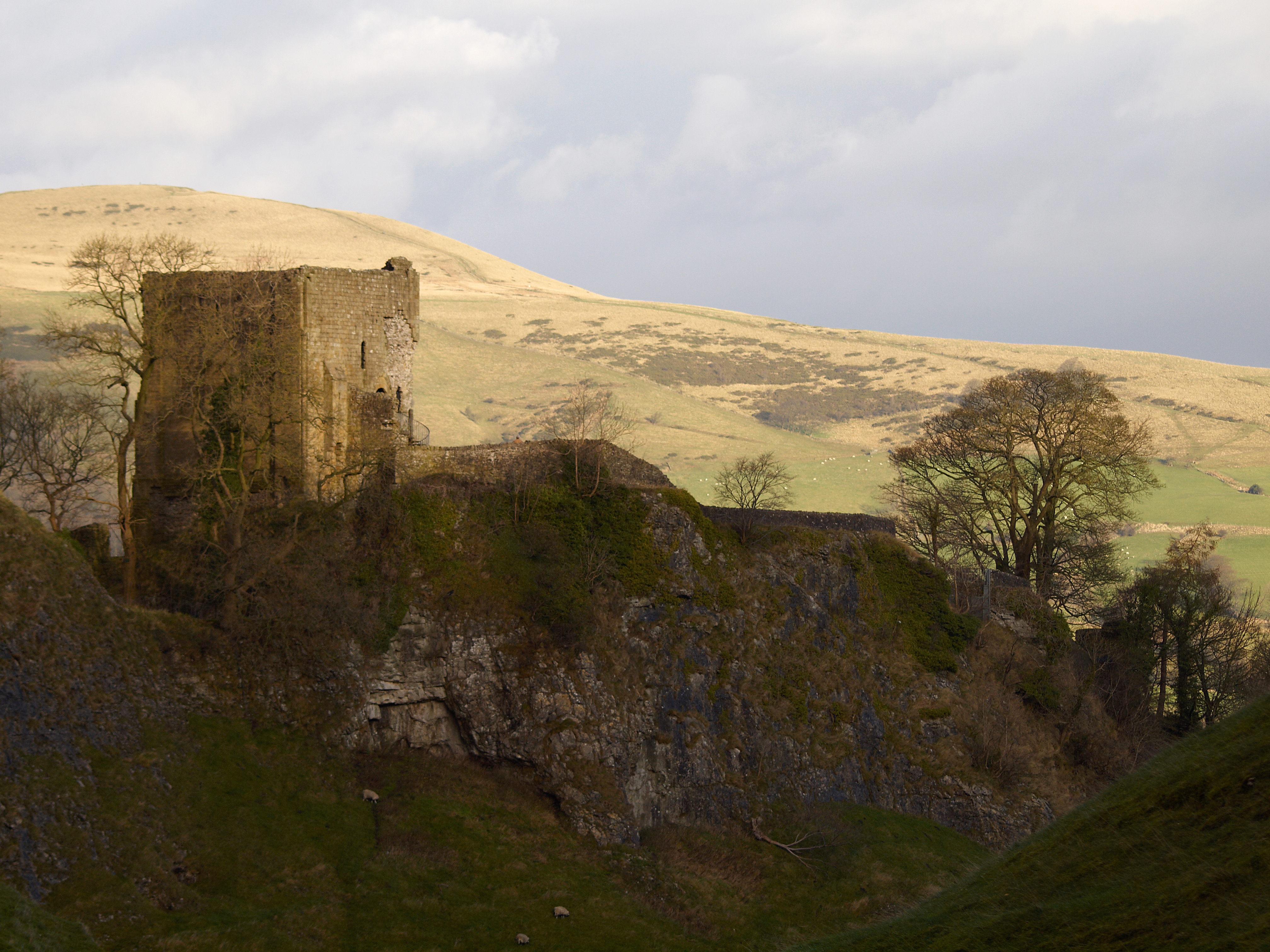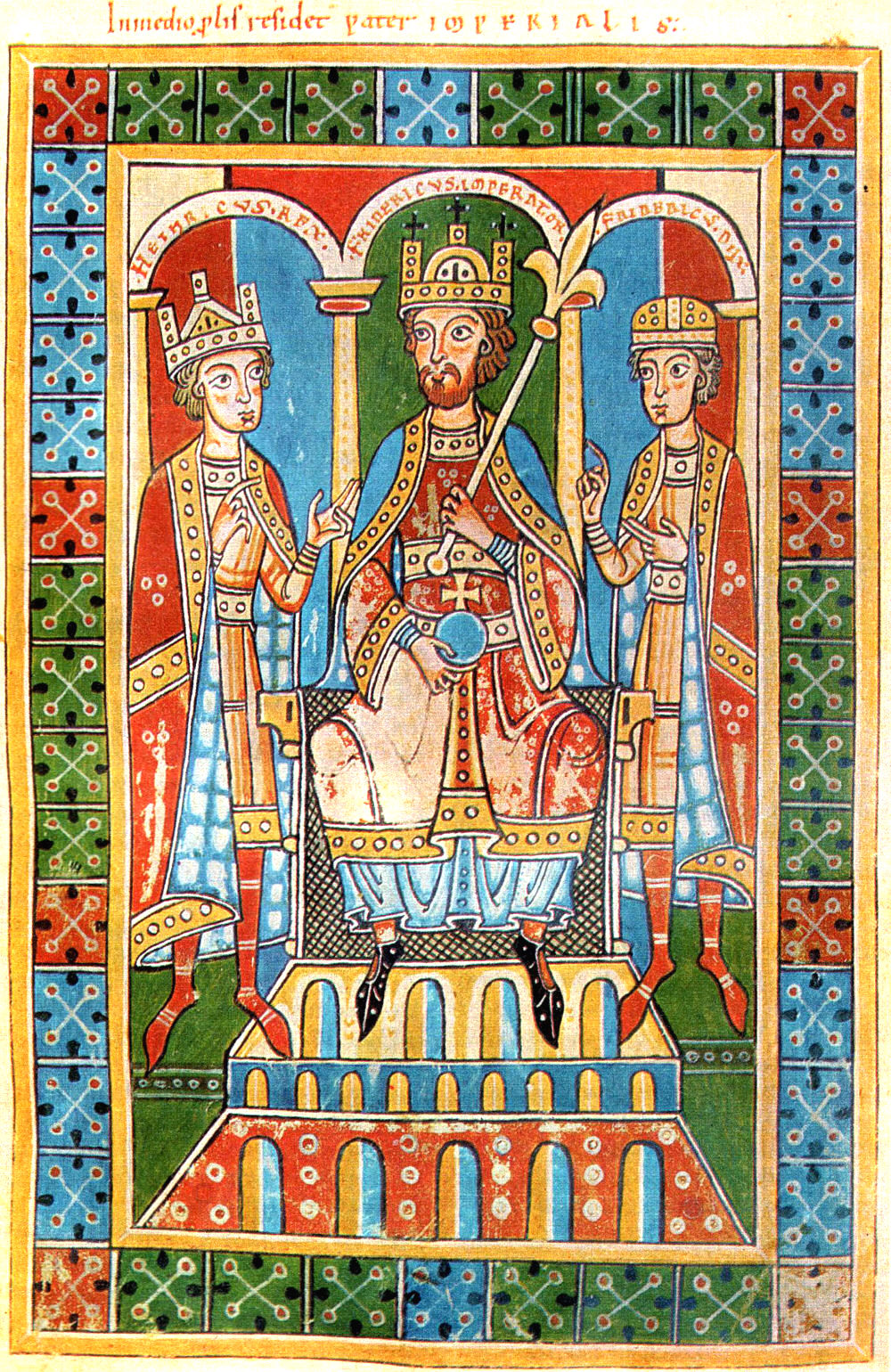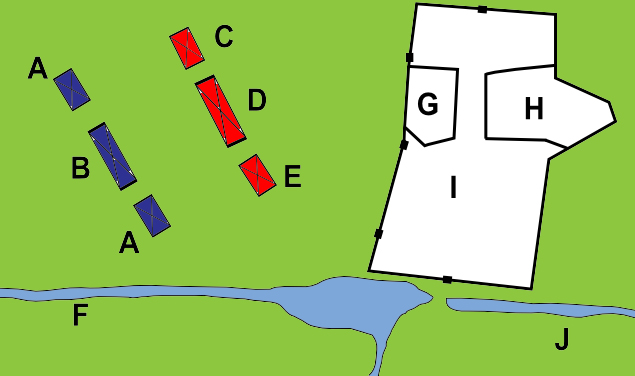|
William Peverel The Younger
William "the Younger" Peverel ( or – after 1155) was the son of William Peverel. He lived in Nottingham, England. He married Avicia de Lancaster (1088 – ) in La Marche, Normandy, France. She was possibly the daughter of William de Lancaster I and Countess Gundred de Warenne, daughter of William de Warenne, 2nd Earl of Surrey. In 1114, she bore a daughter, Margaret Peverel. Another member of his family, Maude Peverel (a sister or daughter) was, by 1120, the first wife of Robert fitz Martin. William inherited the Honour of Peverel. He was a principal supporter of King Stephen, and a commander in the Battle of the Standard. He was captured at the Battle of Lincoln in 1141. King Henry II dispossessed William of the Honour in 1153, for conspiring to poison Ranulf de Gernon Ranulf II (also known as Ranulf de Gernon), 4th Earl of Chester (1099–1153), was an Anglo-Norman baron who inherited the honour of the palatine county of Chester upon the death of his father Ranulf ... [...More Info...] [...Related Items...] OR: [Wikipedia] [Google] [Baidu] |
Scottish Atrocities
Scottish usually refers to something of, from, or related to Scotland, including: *Scottish Gaelic, a Celtic Goidelic language of the Indo-European language family native to Scotland *Scottish English *Scottish national identity, the Scottish identity and common culture *Scottish people, a nation and ethnic group native to Scotland *Scots language, a West Germanic language spoken in lowland Scotland *Symphony No. 3 (Mendelssohn), a symphony by Felix Mendelssohn known as ''the Scottish'' See also *Scotch (other) *Scotland (other) *Scots (other) *Scottian (other) *Schottische * {{disambiguation Scottish people, Language and nationality disambiguation pages ca:Escocès ... [...More Info...] [...Related Items...] OR: [Wikipedia] [Google] [Baidu] |
Honour Of Peverel
The Honour of Peverel (also known as the Feudal Barony of the Peak) is a geographic area in the north of England comprising part of the historic feudal barony held by the Norman Peverel family. The honour was granted to William Peverel (c. 1050 – c. 1115) by William the Conqueror. The Honour is recorded in the Domesday Book of 1086, and consisted of substantial lands comprising 162 manors including: * Bolsover Castle - which became the seat of the Peverel family * Nottingham Castle * Codnor Castle *Pinxton * Duston * Peveril Castle in Castleton, Derbyshire *Glapwell Glapwell is a village and civil parish on the A617 road in the Bolsover District of north east Derbyshire, between the towns of Chesterfield (7 miles) and Mansfield (5 miles) and Bolsover (3 miles to the north). With 1,467 residents, increasing ... * Eastwood, Nottinghamshire *Langar Hall William Peverel's son, William Peverel the Younger, inherited the honour, but, accused of treason by King Henry II ... [...More Info...] [...Related Items...] OR: [Wikipedia] [Google] [Baidu] |
12th-century English People
1 (one, unit, unity) is a number representing a single or the only entity. 1 is also a numerical digit and represents a single unit of counting or measurement. For example, a line segment of ''unit length'' is a line segment of length 1. In conventions of sign where zero is considered neither positive nor negative, 1 is the first and smallest positive integer. It is also sometimes considered the first of the infinite sequence of natural numbers, followed by 2, although by other definitions 1 is the second natural number, following 0. The fundamental mathematical property of 1 is to be a multiplicative identity, meaning that any number multiplied by 1 equals the same number. Most if not all properties of 1 can be deduced from this. In advanced mathematics, a multiplicative identity is often denoted 1, even if it is not a number. 1 is by convention not considered a prime number; this was not universally accepted until the mid-20th century. Additionally, 1 is the ... [...More Info...] [...Related Items...] OR: [Wikipedia] [Google] [Baidu] |
1155 Deaths
Year 1155 ( MCLV) was a common year starting on Saturday (link will display the full calendar) of the Julian calendar. Events By place Europe * Siege of Tortona: German forces capture the citadel of Tortona (after a two-month siege). The city is razed to the ground, including the graves. * June 18 – King Frederick I (Barbarossa) is crowned as Emperor of the Holy Roman Empire by Pope Adrian IV at St. Peter's Basilica in Rome. * Arnold of Brescia is exiled by Adrian IV and forced to flee. He is arrested by imperial forces; hanged and his body burned at the stake in Rome. * The city of Bari rebels against King William I (the Bad) of Sicily and recognizes the Byzantine emperor, Manuel I (Komnenos), as its overlord. * The Virgin of Vladimir (or Our Lady of Vladimir) is taken by Grand Prince Andrey Bogolyubsky to Vladimir from Suzdal. England * Spring – King Henry II has the Palace of Westminster (which is badly damaged by Stephen's supporters during The An ... [...More Info...] [...Related Items...] OR: [Wikipedia] [Google] [Baidu] |
Ranulf De Gernon, 4th Earl Of Chester
Ranulf II (also known as Ranulf de Gernon), 4th Earl of Chester (1099–1153), was an Anglo-Norman baron who inherited the honour of the palatine county of Chester upon the death of his father Ranulf le Meschin, 3rd Earl of Chester. He was descended from the Counts of Bessin in Normandy. In 1136 David I of Scotland invaded England as far as Durham, which led Stephen of England to negotiate treaties that involved granting Ranulf's lands to Scotland. Thereafter, Ranulf allied himself to Matilda to further his cause. He took Lincoln Castle in 1141, which was retaken by Stephen in a siege in which Ranulf was forced to flee for his life. Ranulf enlisted the help of Robert, 1st Earl of Gloucester to retake the castle and succeeded when King Stephen surrendered to him at Lincoln. While Matilda ruled England, Stephen's queen Matilda of Boulogne managed to defeat Ranulf and his allies at Winchester, which eventually resulted in Stephen being able to resume the throne. Biography Early l ... [...More Info...] [...Related Items...] OR: [Wikipedia] [Google] [Baidu] |
Henry II Of England
Henry II (5 March 1133 – 6 July 1189), also known as Henry Curtmantle (french: link=no, Court-manteau), Henry FitzEmpress, or Henry Plantagenet, was King of England from 1154 until his death in 1189, and as such, was the first Angevin king of England. King Louis VII of France made him Duke of Normandy in 1150. Henry became Count of Anjou and Maine upon the death of his father, Count Geoffrey V, in 1151. His marriage in 1152 to Eleanor of Aquitaine, former spouse of Louis VII, made him Duke of Aquitaine. He became Count of Nantes by treaty in 1158. Before he was 40, he controlled England; large parts of Wales; the eastern half of Ireland; and the western half of France, an area that was later called the Angevin Empire. At various times, Henry also partially controlled Scotland and the Duchy of Brittany. Henry became politically involved by the age of 14 in the efforts of his mother Matilda, daughter of Henry I of England, to claim the English throne, then occupied b ... [...More Info...] [...Related Items...] OR: [Wikipedia] [Google] [Baidu] |
Battle Of Lincoln (1141)
The Battle of Lincoln, or the First Battle of Lincoln, occurred on 2 February 1141 in Lincoln, England between King Stephen of England and forces loyal to Empress Matilda. Stephen was captured during the battle, imprisoned, and effectively deposed while Matilda ruled for a short time. Account The forces of King Stephen of England had been besieging Lincoln Castle but were themselves attacked by a relief force loyal to Empress Matilda and commanded by Robert, 1st Earl of Gloucester, Matilda's half-brother. The Angevin army consisted of the divisions of Robert's men, those of Ranulf, Earl of Chester and those disinherited by Stephen, while on the flank was a mass of Welsh troops led by Madog ap Maredudd, Lord of Powys, and Cadwaladr ap Gruffydd. Cadwaladr was the brother of Owain, King of Gwynedd, but Owain did not support any side in the Anarchy. Stephen's force included William of Ypres; Simon of Senlis; Gilbert of Hertford; William of Aumale, Alan of Richmond and Hu ... [...More Info...] [...Related Items...] OR: [Wikipedia] [Google] [Baidu] |
Battle Of The Standard
The Battle of the Standard, sometimes called the Battle of Northallerton, took place on 22 August 1138 on Cowton Moor near Northallerton in Yorkshire, England. English forces under William of Aumale repelled a Scottish army led by King David I of Scotland. King Stephen of England, fighting rebel barons in the south, had sent a small force (largely mercenaries), but the English army was mainly local militia and baronial retinues from Yorkshire and the north Midlands. Archbishop Thurstan of York had exerted himself greatly to raise the army, preaching that to withstand the Scots was to do God's work. The centre of the English position was therefore marked by a mast (mounted upon a cart) bearing a pyx carrying the consecrated host and from which were flown the consecrated banners of the minsters of Durham, York, Beverley and Ripon: hence the name of the battle. This cart-mounted standard was a very northerly example of a type of standard common in contemporary Italy, where it ... [...More Info...] [...Related Items...] OR: [Wikipedia] [Google] [Baidu] |
Stephen Of England
Stephen (1092 or 1096 – 25 October 1154), often referred to as Stephen of Blois, was King of England from 22 December 1135 to his death in 1154. He was Count of Boulogne '' jure uxoris'' from 1125 until 1147 and Duke of Normandy from 1135 until 1144. His reign was marked by the Anarchy, a civil war with his cousin and rival, the Empress Matilda, whose son, Henry II, succeeded Stephen as the first of the Angevin kings of England. Stephen was born in the County of Blois in central France as the fourth son of Stephen-Henry, Count of Blois, and Adela, daughter of William the Conqueror. His father died while Stephen was still young, and he was brought up by his mother. Placed into the court of his uncle Henry I of England, Stephen rose in prominence and was granted extensive lands. He married Matilda of Boulogne, inheriting additional estates in Kent and Boulogne that made the couple one of the wealthiest in England. Stephen narrowly escaped drowning with Henry I's son, William ... [...More Info...] [...Related Items...] OR: [Wikipedia] [Google] [Baidu] |
Robert Fitz Martin
Robert fitz Martin ( 10?? – c. 1159) was a knight from Devon whose father, Martin de Turribus, was the first Norman Lord of Kemes, in what had previously been the Dyfed part of Deheubarth. Fitz Martin inherited the Lordship of Kemes from his father, and founded St Dogmaels Abbey c. 1118. He was the first of the FitzMartin line. His descendants continued to hold lands in England and Wales until the 14th century. Family background Robert fitz Martin, was of a Frankish noble house of Blois, the great-grandson of the bellicose Eudus II, Count of Blois. He was born some time in the late 11th century to a knight of William the Conqueror, Martin de Turribus and his wife Geva de Burci, heiress of Serlo de Burci. Martin had participated in the seizure of Rhys ap Tewdwr's lands, following the latter's refusal to acknowledge the suzerainty of William Rufus (despite having acknowledged the suzerainty of William the Conqueror), consequent attack on Worcester,''The history of Wales, desc ... [...More Info...] [...Related Items...] OR: [Wikipedia] [Google] [Baidu] |
William Peverel
William Peverel († 28. January 1114), Latinised to Gulielmus Piperellus), was a Norman knight granted lands in England following the Norman Conquest. Origins Little is known of the origin of the William Peverel the Elder. Of his immediate family, only the name of a brother, Robert, is known.''The Complete Peerage'', Vol IV, App. I, pp 761–770, "Peverel Family". This also dismisses the Tudor-era genealogical invention that made him illegitimate son of William the Conqueror (after William Camden, Britain or a chorographicall description... (1637) p.550-551) J. R. Planché derives the surname from the Latin ''puerulus'', the diminutive form of ''puer'' (a boy), thus "a small boy", or from the Latin noun ''piper'', meaning "pepper". Lands held in England William Peverel was a favourite of William the Conqueror. He was greatly honoured after the Norman Conquest, and received as his reward over a hundred manors in central England from the king. In 1086, the Domesday Book re ... [...More Info...] [...Related Items...] OR: [Wikipedia] [Google] [Baidu] |
Margaret Peverel
Margaret Peverell, Countess of Derby (b. circa 1114, Nottinghamshire, England), was an English noblewoman who lived at Tutbury Castle in Staffordshire, England. Family and marriage Margaret was the daughter of William Peverel the Younger of Peveril Castle in DerbyshireSheppard, Walter Lee, F.A.S.G., "Royal Bye-Blows: The Illegitimate Children of the English Kings," ''New England Historical and Genealogical Register'' 119(2):95 According to Burke's Dormant, Abeyant, Forfeited and Extinct Peerages, she married Robert de Ferrers, 2nd Earl of Derby and thus became Countess of Derby. She was the mother of William de Ferrers, 3rd Earl of Derby and William De Ferrers, Lord of Eggington and a daughter, Petronella. She died in 1154 and was buried in Merevale Abbey Merevale is a small village and civil parish in the North Warwickshire district of the county of Warwickshire in England. Located about one and a half miles west of Atherstone, it is the site of a medieval Cistercian Ab ... [...More Info...] [...Related Items...] OR: [Wikipedia] [Google] [Baidu] |







